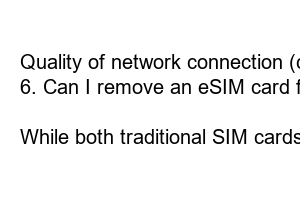유심 이심 차이
Title: Understanding the Difference between SIM Card and eSIM Card
Introduction:
In today’s fast-paced world, mobile communication is an essential part of our daily lives. A significant aspect of this communication is the use of SIM cards, which allow us to connect to our mobile networks. However, with technological advancements, a new form of SIM card called eSIM has emerged. In this blog post, we will explore the key differences between a traditional SIM card and an eSIM card.
1. Physical Presence:
A traditional SIM card is a small plastic chip that needs to be inserted into a compatible device’s SIM card slot. On the other hand, an eSIM is built into the device itself and does not require physical handling or swapping.
2. Flexibility and Convenience:
A conventional SIM card requires manual swapping or transferring between devices when switching phones or service providers. In contrast, an eSIM provides convenience as it allows users to switch between multiple networks without needing to change physical SIM cards, offering greater flexibility and ease of use.
3. Device Compatibility:
Traditional SIM cards are compatible with most devices that have a SIM card slot, including smartphones, tablets, and basic feature phones. eSIM, however, is only supported by a select number of newer devices such as the latest iPhones, Google Pixel phones, and certain smartwatches.
4. Activation Process:
To activate a traditional SIM card, users generally need to visit a physical store, present identification documents, and complete a process involving paperwork and manual activation. On the other hand, activating an eSIM is a much simpler process. Users can easily activate an eSIM remotely via a QR code or through an online portal, significantly reducing the hassle associated with physical SIM cards.
5. Network Switching:
With a traditional SIM card, changing network providers involves obtaining a new SIM card and undergoing the activation process again. Conversely, an eSIM allows for seamless network switching without requiring the physical replacement of a SIM card. Users can simply select and switch their network provider through their device settings.
6. Storage Capacity:
Traditional SIM cards have limited storage space, typically storing contact numbers and a limited amount of text messages. In contrast, eSIM cards have greater storage capacity, allowing for the storage of multiple network profiles, including various service providers.
FAQs:
1. Can I use my existing SIM card with eSIM technology?
No, a traditional SIM card and an eSIM card are not compatible with each other. Each requires separate hardware and software support within the device.
2. Are there any additional charges for using eSIM?
Some network providers may charge a nominal fee for activating and using an eSIM, while others offer it as a free service. It is best to check with your service provider for specific details.
3. Can I use eSIM for international travel?
Yes, eSIM technology is particularly useful for international travel, as it enables users to easily switch and connect to local networks without the need for physical SIM cards. However, network availability and support may vary by region and carrier.
4. Can I switch back to a traditional SIM card from an eSIM?
Yes, users can switch back to using a traditional SIM card on devices that support both options. However, a physical SIM card will need to be inserted, and the activation process will need to be completed.
5. Does eSIM offer better call quality or internet speed?
Quality of network connection (call and internet) depends on network coverage and not the type of SIM card used. Both traditional SIM cards and eSIMs can support high-quality communication and internet connectivity.
6. Can I remove an eSIM card from a device?
As eSIM cards are built into the device, they cannot be physically removed or transferred to another device. However, users can switch eSIM profiles or deactivate them through their device settings.
Summary:
While both traditional SIM cards and eSIM cards serve the purpose of connecting us to mobile networks, they differ in terms of physical presence, flexibility, activation process, device compatibility, and network switching. The eSIM offers greater convenience, seamless switching between networks, and a higher storage capacity. With the continuous evolution of mobile technology, the eSIM is steadily gaining popularity as the future of SIM card technology.

